
For all the moments of contrived spontaneity at the 58th Annual Grammy Awards in 2016, one presentation stood out for its actual authenticity. It came just before Stevie Wonder and the members of the a cappella quintet Pentatonix revealed the winner of the Song of the Year. In a stroke of programming genius, Wonder was given the task of opening the award envelope and pulling out the card with the name of the winner written on it.
“A lot of sighted people were making decisions for the blind rather than the other way around.”
The sight gag might have ended there—for those who’ve been living under a rock, Wonder is blind—but the words “Ed Sheeran” and “Thinking Out Loud” had been embossed on the card especially for the unsighted singer. Running his famous fingertips over the raised dots, Wonder turned the card toward the television cameras he could not see but knew were there, smiled broadly, and teased his co-presenters and audience alike with “You can’t read it; you can’t read Braille” in a good-natured, singsong taunt.
Before announcing the name of the winner, Wonder declared that “we need to make every single thing accessible to every single person with a disability,” cueing the nodding of heads to his left and right. Watching this live on TV, I nodded, too, but the card in Wonder’s hand got me thinking: Who made it, and have people with visual impairments always been able to emboss combinations of raised dots on a sheet of paper so that an unsighted recipient could read what was on their mind, as easily as Stevie Wonder read Ed Sheeran’s name at the Grammys?
Finding the answer to the first question took a bit of basic detective work, but turned out to be straightforward. According to Sergio Oliva, the Director of Programs and Services for the Los Angeles-based Braille Institute of America, the “Braille Institute ‘brailled’ the card for Stevie Wonder.” Mystery solved.

Top: Stevie Wonder teases members of Pentatonix and a live television audience for their inability to read Braille. Above: The Hall Braille-writer, 1892, was the first commercially successful typewriter-like device made to help unsighted writers compose letters for unsighted readers. (Courtesy Antique Typewriters)
More complicated is the history of the devices designed to give unsighted writers the means to communicate with similarly sightless readers. Their story begins in the first half of the 1890s, when two such machines competed for the attention of the visually impaired—the Hall Braille-writer, introduced in 1892, and the Kleidograph, which debuted in 1894.
Strictly speaking, neither of these devices were typewriters, which began their rise to ubiquity in 1874, when gun manufacturer E. Remington & Sons produced the Sholes & Glidden Type Writer. But both the Braille-writer and the Kleidograph leveraged the popularity of typewriters, which by the 1890s were so widespread, it was not uncommon for people who were blind to be trained on them to take dictation and type letters they could not read, which they did with great accuracy and at great speed.
That’s actually where the idea of a typewriter for the blind came from says Norman Ball, who’s writing a book on this subject and was introduced to me by frequent Collectors Weekly contributor and typewriter collector Martin Howard.
According to Ball, the idea for the first machine, the Braille-writer, came to its inventor, Frank Hall, when Hall was serving as the superintendent of the Illinois Institution for the Education of the Blind in Jacksonville. The idea was planted in 1890, shortly after his arrival at the institution, when Hall purchased 15 regular typewriters for his students. Hall was what we’d describe today as an early adopter, using an Edison phonograph (an 1877 invention) as a dictating device to help students practice at their keyboards. Indeed, Hall was so comfortable with the work of his students that he had them type his personal correspondence.

Braille is a tactile reading system in which points or dots designating letters of the alphabet are arranged two across and three high. (Courtesy Antique Typewriters)
When they weren’t typing his correspondence on regular typewriters, Hall’s students read a form of tactile type with their fingers called New York Point. In the early 1890s, Braille was widely used throughout the world, but it was only one of more than 30 tactile systems used by the blind in the United States. Hall noticed, though, that his students had learned Braille themselves, choosing it over New York Point for their private correspondence. “When Hall saw that,” Ball says, “he thought, ‘If the students prefer Braille, maybe we ought to become a Braille school.’ He made that decision very early on.”
By 1891, Hall turned his attention to giving his students a better tool to communicate with each other. At the time, when a blind person wanted to write something for people to read later, they’d use a tablet and a stylus. Aided by a guide, they would press the stylus into the paper, creating patterns of dots, which could be read when the paper was turned over. “That meant every letter had to be formed backwards, and you had to work right to left,” Ball says. “It was quite time-consuming. Everybody recognized that typewriters were important for communication,” he adds. “The blind were asking, ‘Why can’t we get one, too?’”
Combining his students’ facility with typewriters and their enthusiasm for Braille, Hall and a Jacksonville electrical contractor named Gus Sieber created the first Hall Braille-writer in 1892. Later that year, the Munson Typewriter Company of Chicago manufactured around 100 of the machines, some of which were sent to similar schools for the blind in Pennsylvania and Missouri, where unsighted students immediately embraced them.
Unlike typewriters of that era, which featured dozens of keys arranged in horizontal or semi-circular rows, the Hall Braille-writer got by with just six keys plus a space bar. Looking less like a typewriter than a miniature piano, the Hall Braille-writer permitted a writer to emboss any combination of the six dots, or points, that were used in what was then called American Braille by depressing multiple keys in an act known as chording, using one or both hands. The carriage holding the sheet of paper being embossed advanced automatically after each chord so the user could chord the next letter.

The Kleidograph of 1894 was a competitor to the Hall Braille-writer. It composed in a tactile language called New York Point, whose dots were two high and from one-to-four across. (Courtesy Antique Typewriters)
By all rights, the success of the Hall Braille-writer and its successor, the Hall Stereotype Maker (it allowed writers to emboss Braille points on copper printing plates), should have been the first and last devices of their kind. After all, Braille had been in use since 1829, when a 20-year-old, unsighted Frenchman named Louis Braille published a description of the six-dot language he’d invented five years earlier at the age of 15. Unfortunately, as Hall had learned when he arrived at Illinois, American Braille was not the only language taught to and used by the unsighted, which meant that people who could not read and write in American Braille could not use the Hall Braille-writer. They needed a device that spoke their language, the biggest of which, other than American Braille, was New York Point.
“I think Helen Keller’s perspective was very important because of her firsthand experience.”
For Norman Ball, the reasons why New York Point was such a major player at the end of the 19th century are difficult to sum up neatly. The first problem, though, was definitely that the blind were rarely consulted about what people thought would be good for them. “To a large extent,” Ball says, “a lot of sighted people were making decisions for the blind rather than the other way around.” Hall’s observation of the tactile-language preferences of his students in Illinois, it turns out, was the exception rather than the rule. “There was also an awful lot of politics involved,” Ball continues, “driven in part by what economists call ‘sunk costs.’ Textbooks had already been made for the blind. If you’ve got a lot of books in New York Point, do you really want to render those obsolete and commit scarce resources to producing new ones in American Braille? And if you did, then there’d be the time and expense of getting all the teachers up to speed in the new language.”
The other factor, which for Ball is more of a hunch than a fact based on hard evidence, may have been psychological. As its name suggests, New York Point was used in New York State, chiefly at what was then called the New York Institute for the Blind. Braille came from France. “The United States has a long history of isolationism,” Ball says. “New York Point was not an international system. It didn’t allow the blind to participate in the larger international world of communications.” Some people, Ball suggests, were apparently just fine with that.

Students at the New York Institute for the Blind preparing to compose on the Kleidographs. (Courtesy Antique Typewriters)
William Bell Wait may have been one such go-it-aloner, although isolationism does not appear to have been the sole motivation for his advocacy of New York Point. When Wait became the New York Institute for the Blind’s superintendent in 1868, he introduced New York Point as an alternative to Braille—some histories identify Wait as New York Point’s inventor, but Ball does not believe that claim is crystal clear. Regardless of who deserves the credit or blame, Wait and other educators believed the vertical orientation of Braille—two dots across and three up in what’s called a fixed-dot cell—was a poor use of space, making documents embossed in Braille larger than they needed to be. The New York Point system of eight dots—only two up and one-to-four across, with the width collapsing or expanding depending on need—addressed that concern. By 1871, the American Association of Instructors of the Blind appeared to agree when it endorsed New York Point and recommended it for use in the United States.
What followed was the War of the Dots, a fight over tactile formats that would not be resolved conclusively until 1932. As the direct competitor to the Hall Braille-writer, the Kleidograph, which Wait did invent, was a key early combatant in this fight.
Like the Hall Braille-writer, the Kleidograph—its name a derivation of the Greek roots “kleid” for “key” and “graph” for “writing”—allowed users to chord rather than type one key at a time. Its 14 keys and space bar were more typewriter-like in appearance than the Hall Braille-writer’s, and the Kleidograph needed every last one of them, in part because of New York Point’s eight-dot configuration but also because two of the Kleidograph’s keys were designated for punctuation. But the Kleidograph had one important advantage over the Hall Braille-writer—all of its chords could be produced with one hand, leaving the other to read the text one had just composed.

Both the Hall Braille-writer and the Kleidograph were followed by similar machines designed to not only compose documents in their tactile languages, but to produce copper printing plates so that those documents could be reproduced. At left is the Hall Stereowriter. (Courtesy Antique Typewriters) At right is the Stereograph. (Courtesy Museum of the American Printing House for the Blind)
In fact, punctuation would hasten New York Point’s downfall. According to an account written by Robert Irwin, who lost his sight at the age of 5 and was the Executive Director of the American Foundation for the Blind from 1929 to 1949, it was difficult to make capital letters and numerous kinds of punctuation in New York Point. As a result, “New York Point publishers made little or no use of their cumbersome capitals or their four-dot long hyphens and apostrophes,” Irwin wrote, leaving “most books” unpunctuated.
This deficiency may have persisted were it not for Helen Keller, who, in 1909, sent a letter containing her thoughts on New York Point to a meeting of the Board of Education for the New York Public Schools, which was considering the matter of New York Point versus Braille in upcoming textbooks. In her letter to the board, Keller expressed doubts that a reader could be truly literate without an understanding of punctuation. “I have received letters written on the ordinary ink typewriter from blind persons which contained errors significantly like the defects of New York Point,” Keller wrote, “and I cannot but believe that this illiteracy is traceable to their habitual use of a defective mode of punctographic writing during school years.”

Helen Keller in 1904, the year she graduated from Radcliffe College. Keller could read both Braille and New York Point, and her strong advocacy for the former helped kill the latter.
Even more damning, Keller, who graduated from Radcliffe College in 1904 and knew numerous tactile systems, found New York Point more difficult to read than American Braille. “It wears my reading finger,” she complained, adding, “it is a most trying task to decipher many letters which I get in New York Point. The writers evidently have trouble either with the system or the machine.” Ouch.
“I think Helen Keller’s perspective was very important because of her firsthand experience,” Ball says. “But let’s face it: She was a celebrity, a recognized authority, a household name. She was just incredibly famous.” If Helen Keller didn’t like New York Point and the Kleidograph, then those who were unfamiliar with either would probably be wise to take her word for it.
After Keller’s letter, New York Point limped along for a few more years, but by 1932, it was mostly a memory. American Braille was tweaked until it more closely resembled English Braille, and today a language called Unified English Braille is the standard, which means just about any unsighted person in the English-speaking world would have been able to read the card Stevie Wonder read at the Grammys. While that’s not exactly the equity the artist was talking about, it’s at least a small step in the right direction.
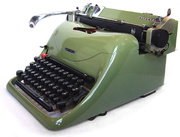
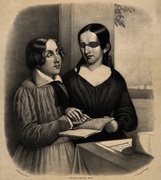 Healing Spas and Ugly Clubs: How Victorians Taught Us to Treat People With Disabilities
Healing Spas and Ugly Clubs: How Victorians Taught Us to Treat People With Disabilities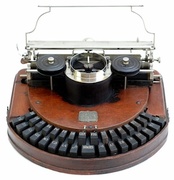
 Dear Tom Hanks: Have We Got a Typewriter for You!
Dear Tom Hanks: Have We Got a Typewriter for You!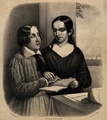 Healing Spas and Ugly Clubs: How Victorians Taught Us to Treat People With Disabilities
Healing Spas and Ugly Clubs: How Victorians Taught Us to Treat People With Disabilities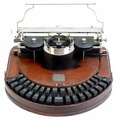 Beautiful Machine: 1881 Hammond Typewriter
Beautiful Machine: 1881 Hammond Typewriter TypewritersWhen you think about it, typing on a computer is a magical thing—just hit t…
TypewritersWhen you think about it, typing on a computer is a magical thing—just hit t… Mari Tepper: Laying it on the Line
Mari Tepper: Laying it on the Line Nice Ice: Valerie Hammond on the Genteel Charm of Vintage Canadian Costume Jewelry
Nice Ice: Valerie Hammond on the Genteel Charm of Vintage Canadian Costume Jewelry How Jim Heimann Got Crazy for California Architecture
How Jim Heimann Got Crazy for California Architecture Modernist Man: Jock Peters May Be the Most Influential Architect You've Never Heard Of
Modernist Man: Jock Peters May Be the Most Influential Architect You've Never Heard Of Meet Cute: Were Kokeshi Dolls the Models for Hello Kitty, Pokemon, and Be@rbrick?
Meet Cute: Were Kokeshi Dolls the Models for Hello Kitty, Pokemon, and Be@rbrick? When the King of Comedy Posters Set His Surreal Sights on the World of Rock 'n' Roll
When the King of Comedy Posters Set His Surreal Sights on the World of Rock 'n' Roll How One Artist Makes New Art From Old Coloring Books and Found Photos
How One Artist Makes New Art From Old Coloring Books and Found Photos Say Cheese! How Bad Photography Has Changed Our Definition of Good Pictures
Say Cheese! How Bad Photography Has Changed Our Definition of Good Pictures Middle Earthenware: One Family's Quest to Reclaim Its Place in British Pottery History
Middle Earthenware: One Family's Quest to Reclaim Its Place in British Pottery History Fancy Fowl: How an Evil Sea Captain and a Beloved Queen Made the World Crave KFC
Fancy Fowl: How an Evil Sea Captain and a Beloved Queen Made the World Crave KFC
Fascinating history.
This is so very interesting. I am studying Braille and am interested in all articles I can find on the history of Braille. Thank you for offering this article.